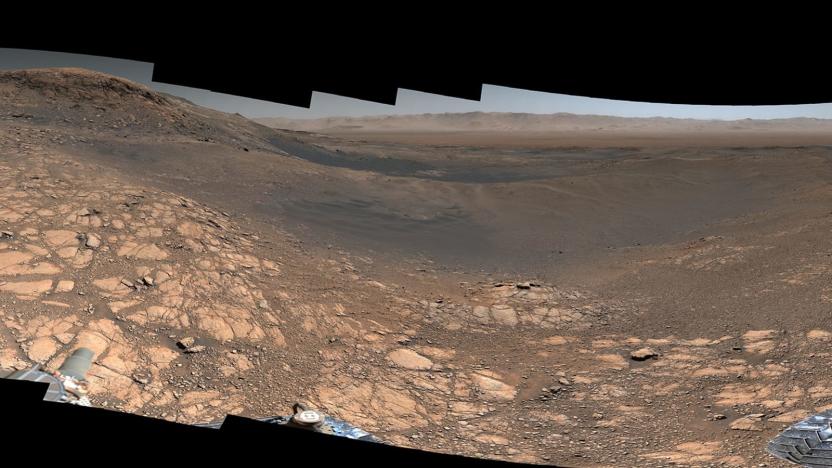Martian
Latest

NASA abandons InSight mission to crack the surface of Mars
Martian soil does not behave in the way NASA engineers expected.
Daniel Cooper01.15.2021
Explore Mars with a 1.8-billion-pixel panorama from the Curiosity rover
NASA's Curiosity rover has sent the highest-resolution panorama of Mars ever taken back to Earth. Now, you can explore the Martian surface by zooming in on the giant 2GB image or cruising around in a 360-degree video that NASA shared on YouTube.
Christine Fisher03.05.2020
Mars One could live again thanks to a mystery investor
Bankrupt Martian colony startup Mars One says it's holding talks with an undisclosed investor to revive its for-profit arm. In a press release, the German company claims to have found a potential savior that could help pay off the one million Euros ($1.1 million) it owes creditors.
Saqib Shah02.12.2019
How NASA will defend the Earth against plagues from outer space
In the summer of 1957, the Earth stood witness as a meteorite cratered in rural Pennsylvania, bringing with it a people-eating plague never seen: an alien amoeba with the taste for human flesh. While we had Steve McQueen around for the first invasion, humanity is now defended against microbial marauders from outer space by NASA and its international counterparts.
Andrew Tarantola11.19.2017
Use Alexa to ask Martian's watches all your burning questions
Have one of Martian's voice-powered smartwatches? Cool, because now mVoice models and certain Guess timepieces will work with Amazon's Alexa technology. "We're excited to work with Martian Watches to bring Alexa to mVoice timepieces so customers can easily perform everyday tasks -- like controlling their smart home with ecobee, requesting a ride with Lyft or checking the daily news -- using just their voice," Amazon's director of voice services Aaron Brown said in a statement. Just think, now you can use Alexa on your watch (or via the mVoice app), to order another voice-controlled watch, just by asking. The future is a wild place, y'all.
Timothy J. Seppala12.06.2016
ESA releases first color photos of the EXOMARS crash site
The ESA's EXOMARS Schiaparelli lander crashed into the Red Planet's crust at more than 300 kph on October 19th, marking not only the end of its mission but also the surface itself. NASA's Mars Reconnaissance Orbiter (MRO) spotted the impact site quickly afterward but it wasn't until this week that its orbit brought the MRO back around. Using its High Resolution Imaging Science Experiment (HiRISE) camera, the MRO snapped the shot you see above.
Andrew Tarantola11.04.2016
Ancient mega-tsunamis hint at cold Martian oceans
3.4 billion years ago, a meteorite smashed into the northern plains of Mars, where an ancient ocean once stood. Its impact threw up a massive wall of liquid water that scarred the surrounding landscape with backwash channels as the water poured back into the Martian sea. A few million years later, after the Red Planet had cooled significantly, another huge chunk of space rock tore into Mars -- however, this time, the resulting tsunami was made of ice blobs that simply stuck wherever they landed rather than return to the sea.
Andrew Tarantola05.19.2016
Researchers grow crops in simulated Martian and Lunar soil
Researchers from the Dutch Wageningen University and Research Center announced on Tuesday that they had successfully cultivated 10 food crops in soil that simulates what astronauts would encounter both on the Moon and on Mars. The team managed to harvest tomatoes, peas, rye, garden rocket, radish and garden cress -- a much better result than the team's initial experiments in 2015 which saw only a few individual plants even germinate.
Andrew Tarantola03.09.2016
ICYMI: Laser-powered spacecraft, upgraded Atlas bot and more
#fivemin-widget-blogsmith-image-139655{display:none;} .cke_show_borders #fivemin-widget-blogsmith-image-139655, #postcontentcontainer #fivemin-widget-blogsmith-image-139655{width:570px;display:block;} try{document.getElementById("fivemin-widget-blogsmith-image-139655").style.display="none";}catch(e){}Today on In Case You Missed It: A professor from California is working on a plan to use photonic propulsion to get a spacecraft to Mars within 72 hours. It would use get the craft off of earth with the power generated by photons leaving a laser.
Kerry Davis02.25.2016
Guess and Martian Watches team up on style-conscious smart wristwear
Apparently, conventional watchmakers couldn't resist the allure of smartwatches for very long. Guess Watches has just unveiled a partnership with Martian Watches to develop style-conscious, voice-guided smart wristwear. Details for the new wearables are scarce right now, but the two brands are promising hardware that doesn't just "try to mimic the smartphone" -- it has to look good on top of being functional. You'll find out more when the first Guess/Martian devices are unveiled in early 2015, but it's safe to presume that Guess will handle most of the external design, while Martian will handle the technology inside.
Jon Fingas08.13.2014
Martian Notifier watch uses custom vibration patterns to signal what app's bugging you
Martian Watches is back at CES this year, bringing with it a new semi-smartwatch in the company's traditional timepiece style. The Martian Notifier, as it's known, is a slight departure from previous efforts given it drops voice control -- the feature that's previously been the company's "hook" (although you can still remotely trigger Siri or Google Now with the press of a button). The watch keeps all other good stuff common to Martian's range, though, like the small OLED screen for displaying contact names or text messages, and the ability to engage a device's camera shutter remotely, among other things. The Notifier pairs with iOS and Android devices via Bluetooth, and as the name suggests, it's focus is on alerting you to notifications. Rather than just vibrating every time something happens on your phone, though, you can select exactly what will trigger a buzz on your wrist. Furthermore, using the companion app, you can set up vibration patterns, so you know one long buzz and two short buzzes means someone's calling you out on Twitter, for example. Any software that uses the iOS or Android notification back-end will feed into the watch app's settings, so you aren't reliant on this or that app specifically including support. While simple, we think it's actually pretty clever, and doesn't look half bad, which is a bonus. Anyone that's intrigued by the Notifier and its semi-smarts will have to wait until Q2 2014 to pick one up, when Martian will start selling them for around 130 bones. Edgar Alvarez contributed to this report.
Jamie Rigg01.06.2014
Martian Passport Watch mixes Bluetooth and class, ships by March for $299 (hands-on)
The world of Bluetooth watches is getting immensely crowded. After years of trying, it seems as if Bluetooth watch makers finally have a captive audience. The Pebble smartwatch seems to be leading the charge in the here and now, but for those looking for something a bit less Jetsons and a bit more Dick Tracy, there's the Martian Passport. At a glance, the unit itself looks very much like a classic wristwatch, replete with analog hand dials, a knob to change the time, and a metallic casing. Look a little closer, however, and you'll spot a 96 x 16 pixel OLED display, capable of displaying contact names for incoming calls and scrolling new text messages. It's a bit thick (0.52 inches), but it houses a battery that can survive a full two hours of yapping, or seven days in standby. Those needing to juice it back up can do so in a couple of hours via the side-mounted micro-USB port. Internally, there's a Bluetooth 4.0 chip (which supports classic Bluetooth and Bluetooth low energy), a vibrating motor for notifications, a three-axis accelerometer, magnetometer, noise-cancellation microphone, and a couple of menu / select buttons on the left. The whole thing is shockingly well built, oozing quality from every possible pore. It'll play nice with iOS and Android devices, and there's an incoming iOS app that'll add even more functionality in the near future. In our testing here at CES 2013, we found the watch to pick up calls and notifications from an iPhone 4S immediately, and the OLED panel was remarkably easy to see even from a few feet away. Chatting into the watch was predictably awkward, but undercover agents should feel right at home. In all seriousness, audio quality was crisp, and folks on the other end had no issues hearing us. And, of course, there's the ability to control the thing via voice. Is it worth the $299 asking price? That's hard to say. The famed Pebble will begin shipping in just over a week for a measly $149, so you'd have to really prefer the look of this guy to pay double. If that's you, you can get your order in through the source link below. %Gallery-175796%
Darren Murph01.11.2013
Curiosity rover starts light robotic arm workout in preparation for scientific main event
As NASA promised, Curiosity has stopped at the quarter pole toward its first scientific destination to test its robotic arm and attached scientific instruments. After 100 yards of driving, the rover extended its 7-foot limb, and will now spend six to ten days checking its predetermined positions and range of motion. That will ensure the appendage is ready after surviving the chilly vaccuum of space and subsequent setdown, and will let its minders see how it functions in the unfamiliar Martian gravity and temperatures. The JPL scientists in charge of the six-wheeler will also peep the Mars Hand Lens Imager and made-in-Canada Alpha Particle X-Ray Spectrometer to warrant that they're up for all the geology to come. If all goes well, the rover will start scooping, drilling and analyzing in earnest when it hits Glenelg, then Mount Sharp -- so, we'd limber up first before tackling all that, too.
Steve Dent09.07.2012
Mars Curiosity leaves its landing area, heads to distant frontier a quarter-mile away
Now that Curiosity has survived its thrill-a-minute landing and passed an upgrade and physical with (nearly) flying colors, the rover is off to earn its $2 billion keep. The trip started well, with the buggy driving 52 feet towards its first science site "beautifully, just as our rover planners designed it," according to NASA. The destination, Glenelg, is 1,500 feet away from the now-familiar Bradbury Landing where it first set down, which is pretty far for a rover that treks along at about a tenth of a mile per hour. On top of that, its minders have some stops in mind to test instruments -- meaning it'll arrive there in about two weeks. Once at Glenelg, Curiosity will scope the unusual geology of the region, though its principal destination for science is Mount Sharp, a relatively vast six miles away. Don't worry about it running out of gas, though -- the nuclear power supply will last a full Martian year, or 687 earth days.
Steve Dent08.30.2012
Voice signals sent to Mars and back, while telephoto images tease rich geology
The Martian hills are alive with the sound of music. Well, NASA Administrator Charles Bolden's voice at least, as the agency reveals that the first recorded human voice has traveled from Earth, to another planet, and back. The words might not have literally echoed in the surrounding hills, but by having been beamed to Curiosity and back again, have made a small step towards interplanetary communication. Along with the motivational words of Bolden, the rover returned some telephoto images from the onboard 100mm and 34mm lenses. The pictures show the hills toward which Curiosity is bound, and tease the scientists with their rich-looking -- and hopefully revealing -- layers of geology. Want to know what interplanetary voicemail sounds like? No need to go to Mars and back, just click on the more coverage link below.
James Trew08.28.2012
NASA scales back Mars exploration, Marvin the Martian thinks it's just lovely
NASA recently showed flashes of its old bravado by announcing plans for a lunar waypoint near the far side of the moon. Cold, hard reality brought the agency back to Earth this week, however, as it just announced a scaling back of its Mars exploration program. Thanks to funding cuts, NASA is scuttling its "ambitious" (i.e. expensive) flagship missions to the Red Planet for the near term. That means withdrawing from the ExoMars missions led by Europe and putting on hold plans to collect samples -- though the Mars Science Laboratory is still a go. NASA is slated to receive $1.2 billion for its planetary science program, down 20 percent from what it gets now, with more cuts likely on the way. In the meantime, the agency is still hopeful about sending humans -- or perhaps a wascally wabbit -- to Mars by the 2030s.
Jason Hidalgo02.15.2012
ESA abandons Russian space probe, hopes it doesn't plummet to earth
Things have gone from bad to worse for the orbit locked Phobos-Grunt space probe, having lost contact with the European Space Agency, the probe faces abandonment and disaster. The soviet star-gazer got stuck in Earth's orbit shortly after launch, stunting its two and a half year jaunt to the Martian moon Phobos. Attempts to send commands that would break the craft loose of the Earth's grip have failed, and the ESA has since given up hope of contacting the probe. The Russians will continue to try and reestablish contact with the probe, hopefully avoiding an expensive disaster. Weighing 13.2 metric tons, most of which is fuel, the probe threatens to return to Earth with a bang, crashing down to terra firma with a toxic payload. It's certainly not been a good couple of months for Euro based space travel. In the meantime let's just hope it doesn't bump into anything else while it's up there, or you might miss the big game.
James Trew12.05.2011
Russian and Chinese satellites going to Martian moon, plan to bring back some of the Red Planet (update: stranded in Earth orbit)
Russia just finished its Mars500 simulation, proving that man can handle the arduous task of traveling to and from the Red Planet -- or at least it proved man can live in a confined space for 520 days with dodgy internet. However, Moscow needs to know a bit more about Mars itself before shooting citizens to our planetary neighbor, so it's sending a satellite to collect soil samples from one of its moons. The Russian satellite, named Phobos-Grunt, launched earlier today with the Chinese satellite Yinghuo-1 onboard as well. Both are bound for the Martian moon Phobos and are scheduled to arrive in September of 2012, whereupon Yinghuo-1 will be dispatched into orbit around Mars and Phobos-Grunt will begin maneuvering for its final descent onto the moon's surface. After landing, a robotic arm will examine some extra-terrestrial soil on site and gather 200 grams more to fire back to terra, where it's scheduled to touch down in Kazakhstan by August of 2014. If humans can get some Martian dirt back to Earth without incident, shouldn't be hard to do the same thing with a man, right? Update: Well, that was quick. It looks like Phobos-Grunt may not be bringing back soil samples from Mars, folks. Apparently, the launch went off without a hitch, but after achieving Earth orbit, the engine needed to get it into deep space failed to fire. Right now the Russians are working on a fix, but Phobos-Grunt has just two weeks of juice in its batteries before it becomes space junk. Good luck, fellas, you're going to need it.
Michael Gorman11.08.2011
Online gaming between Earth and Mars will be laggy as hell
We know that not everyone was blessed with knowledge of aeronautical physics and interplanetary telecommunications, so we'll try and keep this simple. A recent Edge Online article examined the possibility of online multiplayer matches between human Earthlings and human Martians -- as one might expect, the future of galactic Left 4 Dead bouts looks pretty grim.First off, NASA's two Martian orbiters, through which information is relayed to Earth, can only transfer a single megabit of data per second. Worse still, these orbiters only work in 15 minute increments before they must be repositioned -- a process that takes hours. Furthermore, bandwidth is unsurprisingly limited on the Red Planet -- messages between Earth and Mars usually suffer 4 - 20 minutes of lag, depending on the positions of the conversing planets.Check out the full article for even more interesting tidbits about extraterrestrial multiplayer. It's all a bit pointless, though. From what we've recently learned, folks on Mars are far too busy causing property damage to play any video games.
Griffin McElroy08.06.2009
My Favorite Martian
If The Martian DS looks a little rough on the edges, it's because the title was originally created by a team of three for a 72-hour game development competition four years ago. The resulting project is actually quite impressive, considering, and we're happy to see that one of the original developers took the time to create a homebrew port of it for the DS. Short but sweet, The Martian DS is a side-scrolling shooter in the vein of Alien Hominid. Players roam the city picking up weapons and power-ups while dodging constant gunfire from the local law enforcement. The game really suffers from the lack of a soundtrack, but the original character sprites, especially the donut-heaving boss, makes up for it. %Gallery-4955% [Via GBATemp]
Eric Caoili07.17.2007